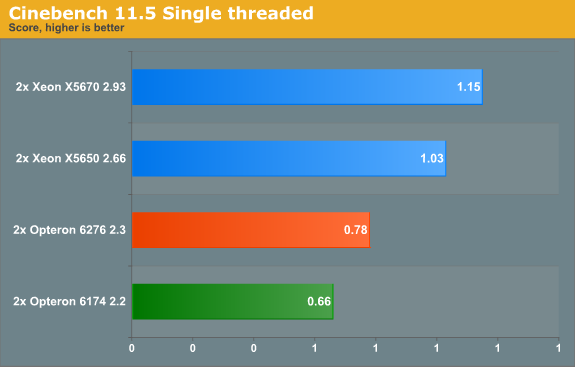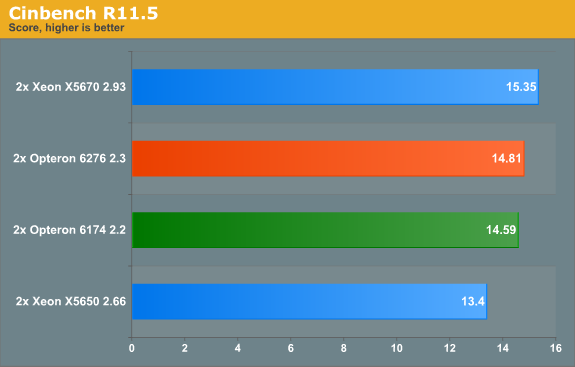Bulldozer for Servers: Testing AMD's "Interlagos" Opteron 6200 Series
by Johan De Gelas on November 15, 2011 5:09 PM ESTRendering Performance: Cinebench
Cinebench, based on MAXON's software CINEMA 4D, is probably one of the most popular benchmarks around, and it is pretty easy to perform this benchmark on your own home machine. The benchmark supports 64 threads, more than enough for our 24- and 32-thread test servers. First we tested single-threaded performance, to evaluate the performance of each core.

Single-threaded performance is relatively poor when you do not enable Turbo Core: with that setting the Opteron 6276 scores only 0.57. So the single-threaded FP performance is about 10% lower, probably a result of the higher FP/SSE latencies of the Interlagos FPU. However, the 6276 Opteron can boost the clock speed to 3.2GHz. This 39% clock speed boost leads to a 37% (!) performance boost. The difference with the older "Istanbul" based Opteron "Magny-cours" 61xx can only get larger once software with support for the powerful FMAC and AVX capable units is available. Also newer compilers will take the longer FP latencies into account and will probably boost performance by a few percent even without using FMAC or AVX.
Before we look at the Multi-threaded benchmark, Andreas Stiller, the legendary German C't Journalist ("Processor Whispers") sent me this comment:
"You should be aware that Cinebench 11.5 is using Intel openMP (libguide40.dll), which does not support AMD-NUMA"
So while Cinebench is a valid bench as quite a few people use the Intel OpenMP libraries, it is not representative of all render engines. In fact, Cinebench probably only represent the smaller part of the market that uses the Intel OpenMP API. On dual CPU systems, the Opteron machines run a bit slower than they should; on quad CPU systems, this lack of "AMD NUMA" awareness will have a larger impact.

We did not expect that the latest Opteron would outperform the previous one by a large margin. Cinebench is limited by SSE processing power. The ICC 11.0 compiler was the fastest compiler of its time for SSE/FP intensive software, even for the Opterons (up to 24% faster than the competing compilers), but it has no knowledge of newer architectures. And of course, the intel compiler does favor the Xeons.
The Opteron 6200 has a total of eight dual issue (if you count only those pipes that do calculations) FPUs, while the Opteron 6100 has a total of 12 dual issue FPUs. The only advantage that the 6200 has (if you do not use the FMAC or AVX capabilities) is that it can interleave two FP threads on one module. So you get 16 FP threads that can dispatch one FP per clock versus 12 FP threads that can dispatch two FP per clock. That capability is especially handy when your threads are blocked by memory accesses. This is hardly the case in Cinebench (but it is probably the reason why Interlagos does so well in some HPC tests) and as a result, the Opteron 6276 cannot pull away from the Opteron 6174.
Anand reported that the best Core i7 (2600K, 4 cores/8 threads, 3.4GHz) achieves 6.86. So considering that a dual Opteron 6200 is cheaper than the dual Xeon, and more manageable than two workstations, such a renderfarm may make some sense.










106 Comments
View All Comments
JohanAnandtech - Thursday, November 17, 2011 - link
1) Niagara is NOT a CMT. It is interleaved multipthreading with SMT on top.
I haven't studied the latest Niagaras but the T1 was a fine grained mult-threaded CPU. It switched like a gatling gun between threads, and could not execute two threads at the same time.
Penti - Thursday, November 17, 2011 - link
SPARC T2 and onwards has additional ALU/AGU resources for a half physical two thread (four logically) solution per core with shared scheduler/pipeline if I remember correctly. That's not when CMT entered the picture according to SUN and Sun engineers any way. They regard the T1 as CMT as it's chip level. It's not just a CMP-chip any how. SMT is just running multiple threads on the cpus, CMP is working the same as SMP on separate sockets. It is not the same as AMDs solution however.Phylyp - Tuesday, November 15, 2011 - link
Firstly, this was a very good article, with a lot of information, especially the bits about the differences between server and desktop workloads.Secondly, it does seem that you need to tune either the software (power management settings) or the chip (CMT) to get the best results from the processor. So, what advise is AMD offering its customers in terms of this tuning? I wouldn't want to pony up hundreds of dollars to have to then search the web for little titbits like switching off CMT in certain cases, or enabling High-performance power management.
Thirdly, why is the BIOS reporting 32 MB of L2 cache instead of 8 MB?
mino - Wednesday, November 16, 2011 - link
No need for tuning - turbo is OS-independent (unless OS power management explicitly disables it aka Windows).Just disable the power management on the OS level (= high performance fro Windows) and you are good to go.
JohanAnandtech - Thursday, November 17, 2011 - link
The BIOS is simply wrong. It should have read 16 MB (2 orochi dies of 8 MB L3)gamoniac - Tuesday, November 15, 2011 - link
Thanks, Johan. I run HyperV on Windows Server 2008 R2 SP1 on Phonem II X6 (my workstation) and have noticed the same CPU issue. I previously fixed it by disabling AMD's Cool'n'Quiet BIOS setting. After switching to high performance increase my overall power usage by 9 watts but corrected the CPU capping issue you mentioned.Yet another excellent article from AnandTech. Well done. This is how I don't mind spending 1 hour of my precious evening time.
mczak - Tuesday, November 15, 2011 - link
L1 data and instruction cache are swapped (instruction is 8x64kB 2-way data is 16x16kB 4-way)L2 is 8x2MB 16-way
JohanAnandtech - Thursday, November 17, 2011 - link
fixed. My apologies.hechacker1 - Tuesday, November 15, 2011 - link
Curious if those syscalls for virtualization were improved at all. I remember Intel touting they improved the latency each generation.http://www.anandtech.com/show/2480/9
I'm guessing it's worse considering the increased general cache latency? I'm not sure how the latency, or syscall, is related if at all.
Just curious as when I do lots of compiling in a guest VM (Gentoo doing lots of checking of packages and hardware capabilities each compile) it tends to spend the majority of time in the kernel context.
hechacker1 - Tuesday, November 15, 2011 - link
Just also wanted to add: Before I had a VT-x enabled chip, it was unbearably slow to compile software in a guest VM. I remember measuring latencies of seconds for some operations.After getting an i7 920 with VT-x, it considerably improved, and most operations are in the hundred or so millisecond range (measured with latencytop).
I'm not sure how the latests chips fare.